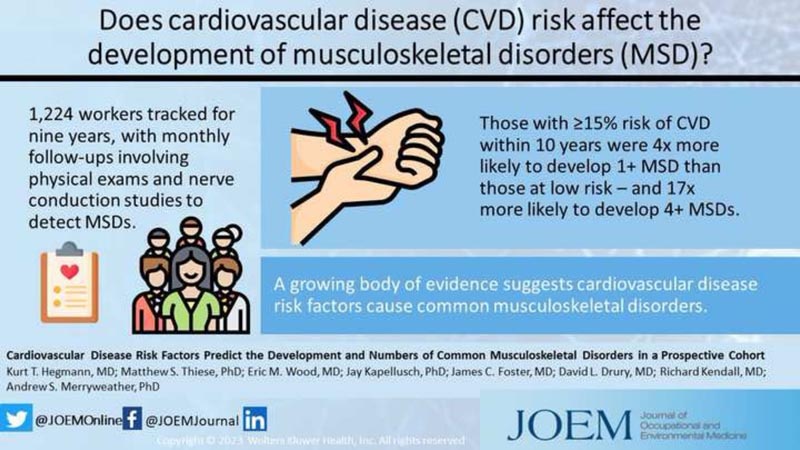Cardiovascular disease risk factors predict development and number of common musculoskeletal disorders in a prospective cohort Summary Aim Assess the risk of common musculoskeletal disorders (MSDs) based on cardiovascular disease (CVD) risk scores. Methods Data were analyzed from a nine-year prospective cohort of 1,224 workers in 3 states. Baseline data included questionnaires, structured interviews, physical examinations, anthropometric measurements, nerve conduction studies, and individualized measurement of physical work factors. Monthly follow-ups were carried out. Framingham risk scores were calculated. A priori case definitions were constructed for carpal tunnel syndrome, lateral epicondylopathy, medial epicondylopathy, and rotator cuff tendinopathy. Results The adjusted RRs for one or more DMTs increased to 3.90 (95% CI, 2.20, 6.90) among those with 10-year CVD risk scores greater than 15% and 17.4 (95% CI %: 3.85, 78.62) among those who had more than 4 disorders. Conclusions CVD factors are strongly associated with the subsequent development of common MSDs. The risks among people with multiple MSDs are considerably higher. |

Comments
People at higher risks for cardiovascular disease are significantly more likely to develop carpal tunnel syndrome, tennis elbow, golfer’s elbow, and rotator cuff tendinitis , according to a new study involving researchers from the University of Utah and the Center for Rocky Mountain Environmental and Occupational Health.
The study findings, published in the Journal of Occupational and Environmental Medicine , have implications for the prevention and treatment of these common musculoskeletal disorders, which affect tens of millions of Americans each year and generate annual costs of more than $6 billion.
The study’s lead author is Kurt Hegmann, MD, a professor at the University of Utah and director of the Rocky Mountain Environmental and Occupational Health Center, a partnership between the University of Utah and Weber State University. He said the strength of the associations the researchers discovered between cardiovascular disease risk factors and musculoskeletal disorders is striking.
“It’s rare that you see 17 times the risk of disease,” Hegmann said.
“These results tell us that prioritizing cardiovascular health is key to preventing these musculoskeletal disorders, which can have a debilitating impact on people’s quality of life. “This is something we and other researchers and medical professionals need to pay close attention to.”
The authors based their research on data from a nine-year prospective cohort of 1,224 workers in various employment sectors in three states. Baseline data were collected at the beginning of the study, including from interviews, physical examinations, anthropometric measurements, and nerve conduction studies, with follow-ups conducted monthly to track the development of symptoms of musculoskeletal disorders.
The authors compared the development of musculoskeletal disorders with the risk of cardiovascular disease through a method based on the Framingham Heart Study model , a widely used tool to assess a person’s 10-year risk of cardiovascular disease. They adjusted their analyzes for a number of factors that could bias the results, such as body mass index and the physical strain of the participants’ work.
The findings suggest that poor cardiovascular health contributes to the development of musculoskeletal disorders. Participants with a 15% or greater risk of cardiovascular disease had:
- Four times greater risk of developing one or more musculoskeletal disorders than those with low risk of cardiovascular disease.
- 17 times higher risk of developing four or more musculoskeletal disorders than those with low risk of cardiovascular disease.
“Obviously, the importance of heart health is no secret,” said Matthew Thiese, PhD, co-author of the Rocky Mountain Center for Occupational and Environmental Health. “We know that people need to adopt healthy behaviors to avoid developing diseases that can shorten their lives. But this study shows that poor outcomes related to musculoskeletal disorders may also be awaiting people who do not take care of their cardiovascular health.”
The musculoskeletal disorders the researchers examined are common among Americans and can affect a person’s quality of life. Previous research estimates that up to 5% of the population suffers from carpal tunnel syndrome, for example, with a much higher prevalence among workers whose jobs require vigorous movement, while up to 41% of people experience tennis elbow or epicondylitis. side. Up to a third of people develop rotator cuff tears.
According to the authors, the study raises questions about whether these types of conditions are a potential "early warning" sign for cardiovascular disease. Musculoskeletal disorders can occur in a person with poor heart health years or decades before symptoms of cardiovascular disease appear.
The findings align with a growing body of evidence that systemic risk factors contribute to the development of musculoskeletal disorders. Limitations of the research include that the study was not a randomized control trial. Randomized studies are the gold standard for testing causality, although these types of exposures cannot be randomized.
The other co-authors associated with the University of Utah included Eric Wood, MD, and Richard Kendall, MD. They conducted the study in collaboration with researchers from the University of Wisconsin-Milwaukee, Infinity Healthcare in Wisconsin, and the Clement J. Zablocki Veterans Affairs Medical Center in Wisconsin.
















